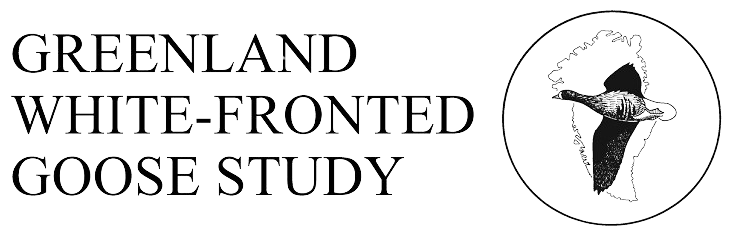History
The species apparently only colonised Colonsay and adjacent Oransay during the 1930s, since there are only two records prior to 1934 (Jardine et al. 1986). Two pinioned pairs of Canada Geese were introduced by Lord Strathcona’s gamekeeper in 1934 to try and increase the numbers of wintering wildfowl on the island (Clark 1977). This plan seemed to work, because by the time that the gamekeeper left the island in 1968, he recalled that an average of c.200 Greenland White-fronted Geese were wintering. Alternatively, it could be the case that there was some major expansion that occurred on the winter quarters at that time, because this “colonisation” was coincident with, for instance, that of Kintyre. Neither Berry (1939) nor A-W (1963) mentioned White-fronted Geese on Colonsay, but there was a symbol indicating 10-100 birds on the island on the distribution map of A-W (1963). R&O (1979) reported regular counts of up to 20 from the 1950s, but reported few after that time, usually encountered during Barnacle Goose aerial surveys. Despite this, Clarke and Clarke (1990) reported that numbers at that time appeared rather less than the 200 or so which were regular by 1968. R&O (1979) noted that none could be found on the island in either April 1973 or April 1978 and speculated over whether the flock had gone or simply that the geese were only present in the first part of the winter. Clarke & Clarke (1990) suggest that there were still c.70 in the late 1970s, but their detailed counts started in 1981/2 when there was a maximum of c.60 present in April 1982. Thus we have very little impression of the distribution, abundance and history of this flock prior to regular monitoring that started in the early 1980s.
Status
National importance (R&O 52). Whatever the earlier status, this flock did certainly seem to increase quite dramatically from 50-80 in the earliest surveys of the 1980s, peaking at 150-300 individuals in the 1990s. There was considerable year to year variation, and it could be the case that movements to and from unknown feeding areas, Oronsay, and potentially even to Islay and further afield, make annual fluctuations amongst this group more markedly that more isolated resorts elsewhere. Since the peak count of 288 in 1997, numbers have declined to the present as is the case at many resorts.
Maximum winter counts:
Breeding success: Assessment of breeding success has not been regular enough on Colonsay to provide a long run of data from the island.
Feeding sites and habitat: Clarke & Clarke (1990) reported the geese using the fields of Kiloran, Machrins, Oransay, Scalasaig and Kilchatten farms in that order of importance. The Greenland White-fronted Geese conspicuously do not use every field on each farm, but seem to favour good grazing away from potential danger. Geese use in-bye fields, rough pasture and improved and managed grasslands away from potential danger, mostly in the vicinity of Kiloran. Clarke & Clarke (1990) speculated on the effects on the geese of changes in grass ley management on the island. In the 1960s, 3-year rotation was the norm and up to 200 geese were reported, but this changed to 7-year leys in the 1970s and the flock numbered 70-80, later in the 1980s 5 year leys became more popular and numbers increased again, albeit during a period of overall population increase. Nevertheless, these changes in grassland management did mean that the average area of grassland reseeded annually changed from 25 ha to 15 ha to 20 ha respectively during these three decades, making a substantial difference to the area of new grass available to this goose flock.
Roosting sites: In the early part of the winter, geese seem to roost in or close to their feeding site (Clarke & Clarke 1990). Later in mid-winter and spring, they use lochs or wet marshy areas away from the feeding areas, such as Loch an Sguid, Ardskenish Point, Loch Fada or the southern part of Oransay.
Habitat change: None known to affect the geese.
Aircraft disturbance: Not known
Hunting disturbance: Not known, but not thought a problem.
Agricultural disturbance: Not known, but not thought significant.
Site safeguard: The feeding areas on Oransay and Loch Fada on Colonsay are protected as SSSI and Oronsay is an RSPB reserve managed sympathetically for the geese.
SNH Natural Heritage Zones/Area: Argyll West and Islands.
Threats: Damage from Greenland White-fronted Geese in recent winters has been cited as the reason for early reseeding of some fields, although Greylags and Barnacle Geese are also present. However, farmers on Colonsay and Oransay have been comparatively tolerant of geese, although any increase in damage could cause problems in the future.
Linkages with other sites: Colonsay and Oransay lie directly on the main migration route to Islay and other wintering areas to the south. Large skeins pass over the island every autumn on obvious “goose days”. They typically travel down the west side of Colonsay, swing south across Ardskenisk peninsula out over Oransay onwards to northern Islay. In contrast, fewer geese are seen migrating in spring. Despite this, only one marked individual has been seen at this resort, and that was a short stopping migrant: A8S was ringed in Isungua, west Greenland in summer 1992 and staged briefly on Colonsay being seen on 15th and 20th October 1992, before continuing to spend the winter at Machrihanish on Kintyre from at least 26th October that year.
References
Clark, M. (1977) Canada Geese breeding and other geese wintering on the island of Colonsay. Western Naturalist 1977: 103.
Clarke, J. & Clarke, P. (1990) Greenland White-fronted Geese on Colonsay and Oransay. pp.19-21 In: GWGS Research Report No.7. Greenland White-fronted Geese in Britain 1987/88-1989/90. GWGS, Aberystwyth.
Jardine, D.C., Clarke, P. & Clarke P.M. (1986) The Birds of Colonsay and Oransay. Their History and Distribution. Privately Published.
